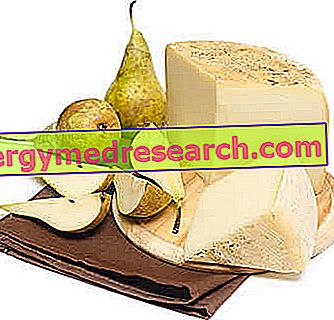What is pecorino romano
Pecorino Romano is the name of an Italian cheese with a hard and cooked paste, produced from whole fresh sheep's milk, and awarded - since 1996 - the DOP recognition (Protected Designation of Origin).

Pecorino Romano is different from Sardinian, Tuscan and Umbrian-Marche, which are less salty and are used mainly as table cheeses; the seasoned Sicilian is instead more similar.
The disciplinary of the DOP pecorino romano circumscribes the production area and the origin of the raw materials (milk, lactic ferments and lamb rennet) to the regions of Lazio and Sardinia (later we will understand better why), as well as the province of Grosseto.
For over two millennia, the Roman pecorino is part of the local gastronomic tradition, so much so that historians have defined it as one of the fundamental foods of the legionary diet in ancient Rome. The pecorino romano is therefore one of the oldest cheeses of the Italian peninsula and is still produced following the same recipe. In the capital, on May 1st it is traditional to make an excursion on the hills or in the surrounding countryside and to eat pecorino romano with fresh broad beans.
Nutritional properties
Nutritional characteristics of Roman pecorino
Pecorino Romano is a product that belongs to the II fundamental group of foods, therefore it is a significant source of essential amino acids, mineral salts and specific vitamins of this category.
It has a high caloric intake, supplied mainly by lipids, followed by peptides and finally by small amounts of carbohydrates.
Fatty acids are mostly saturated, proteins with high biological value and simple carbohydrates.
Does not contain fibers; on the contrary, cholesterol is abundant.
The most important mineral salts are sodium, calcium and phosphorus. The most important vitamins are from group B, especially riboflavin (B2).
Pecorino Romano is a food that does not lend itself to the diet of the overweight person and of those affected by common pathologies of the metabolism. Being rich in salt, therefore sodium, it should be avoided in the case of primary sodium sensitive hypertension. Furthermore, the concentration of saturated fats and cholesterol makes it unsuitable for hypercolesterolemic nutrition. On the other hand, the richness in calcium and phosphorus makes it a product that, wisely used, helps to meet the mineral needs of growing children and people of advanced age (especially menopausal women).
Whether or not its relevance in the diet for lactose intolerance depends on individual sensitivity. Instead it is gluten-free but contains a lot of histamine, which makes it unsuitable for the nutritional pattern of intolerant subjects.
The only allergen is milk proteins.
It is not admitted by the vegan philosophy nor by the vegetarian one, as it requires animal rennet (lamb).
The average portion of pecorino romano is 80 g (about 330 kcal).
| Edible part | 100.0% | |
| water | 31, 9g | |
| Protein | 26, 0g | |
| Lipids TOT | 33, 1g | |
| Saturated fatty acids | - g | |
| Monounsaturated fatty acids | - g | |
| Polyunsaturated fatty acids | - g | |
| Cholesterol | 90, 0mg | |
| TOT Carbohydrates | 1.8g | |
| Starch | 0.0g | |
| Soluble sugars | 1.8g | |
| Dietary fiber | 0.0g | |
| Power | 409, 0kcal | |
| Sodium | - mg | |
| Potassium | - mg | |
| Iron | - mg | |
| Football | 900, 0mg | |
| Phosphorus | 589, 0mg | |
| Thiamine | - mg | |
| Riboflavin | 0, 41mg | |
| Niacin | - mg | |
| Vitamin A | 480, 0μg | |
| C vitamin | 0, 0mg | |
| Vitamin E | 1, 01mg | |
Description
The shapes of the pecorino romano are cylindrical, with a weight of 20-35 kg *, have flat faces, barefoot 25-40 cm and a diameter of 25-35 cm.
The rind is generally thin, ivory or straw white in color; black if captured with protective films that recall the old oiling treatments (grapeseed oil) or umber. On the rind is stamped with the Roman pecorino DOP (stylized head of a sheep) with the appropriate wording, the abbreviation of the province of origin, the code of the dairy and the date of production. In order to specify the province it is necessary that the entire production cycle takes place within the same.
When cut, the consistency of the pecorino romano pasta is compact, white in color and possibly with a few holes.
* The tendency of the production of pecorino romano is to increase the weight of the shapes. In 1916 a weight of between 7-10 kg was observed, while in 1955 already the 8-20 kg were already reached.
Recipes
Gastronomic uses of pecorino romano
Pecorino Romano is used mainly grated, as a condiment for pasta dishes, similar to Grana Padano and Parmigiano Reggiano cheeses. Thanks to its characteristic aroma, intense flavor and salty taste, the pecorino romano is used above all in the richest recipes, such as bucatini all'amatriciana, spaghetti carbonara, pasta alla gricia, Roman-style tripe, spaghetti with cheese and pepper, penne all'arrabbiata etc.

Oenological pairing
To accompany a piece of medium-seasoned Roman pecorino, full-bodied red wines such as Barolo, Barossa Valley Shiraz AUS, Brunello di Montalcino, Colli Orientali del Friuli Schioppettino, Napa Valley Zinfandel USA, Pauillac F Taurasi and Vino Nobile di Montepulciano are suitable.
Production
Outline of production
The pecorino romano is produced exclusively with whole milk, fresh from sheep bred in the regions of Lazio, Sardinia and in the province of Grosseto. The phases of the production cycle can be summarized as follows:
- Milk collection
- Possible heat treatment at 68 ° C for 15 '
- Possible inoculation of biological starters (scalding graft) based on locally produced thermophilic lactic bacteria
- Adding rennet in lamb paste, also locally produced, and waiting for coagulation, keeping the milk at a temperature of 38 ° / 40 ° C
- Breaking the curd into small clots
- Cooking at a temperature ≥ 48 ° C
- Dry salting (older technique) or in brine
- Matured for at least 5 months for table cheese and at least 8 months for grating cheese.
In North America, where 70% of the world consumption of Roman pecorino is concentrated, the less valuable alterego known as the "Roman cheese" is also widespread. The importance of export is such that, once the customs coefficient "* has been reached, the pecorino romano is covered with a protective film that reduces the thickening of the crust.
* Customs coefficient: ratio between moisture of the cheese and lean dry residue ≤ 47% expected to have economic support for exports to the USA.
History
Historical notes on pecorino romano
Pecorino Romano - whose production method was described for the first time by certain Latin authors, such as Varro and Plinio il Vecchio, about 2000 years ago - has its origins in the countryside of Rome.
Its conservation capacity made it the ideal food for the legionary sustenance in ancient Rome; during the marches of war or of reconnaissance, each legionary was assigned a ration of bread and spelled soup with 27 g of pecorino romano. Many historians attribute to this cheese a part of the merits in the conquests of the Roman army; with its caloric power, it was able to restore vigor and energy to the soldiers in the pauses between battles.
Until the middle of the nineteenth century, the production of Roman pecorino was limited to the Lazio region. In 1884, due to the municipal ban on salting cheese, many producers moved to Sardinia; today, most of the cheese is produced on the island (around 90%), especially in Gavoi.



